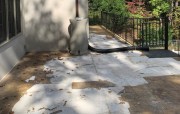Steven P. Widoff Photography
Specialty admixtures have many benefits, along with some potenti…
Waterproofing Admixtures
Watertightness is a key performance criterion for concrete structures designed for the containment, treatment, or transmission of water, wastewater, or other fluids. From a concrete perspective, watertightness can be achieved by using a well-proportioned, low permeability, workable concrete that is properly consolidated and cured. Also, cracking of the concrete must be minimized. Increasingly, waterproofing admixtures, in particular crystalline-based waterproofing admixtures, are being specified for concrete structures where there is a need to minimize water movement through the concrete.
Shrinkage-Reducing and Crack-Reducing Admixtures
The benefits of the durability-enhancing admixtures discussed up to this point can be compromised if the concrete cracks, because cracking will facilitate the ingress of aggressive agents or movement of water through the concrete. Cracking cannot be controlled 100%, but it can be minimized by designing for volume change and also proportioning the concrete for low shrinkage and cracking.
In addition to the traditional methods of reducing drying shrinkage (such as minimizing the total water and paste content of a concrete mixture), shrinkage-reducing admixtures (SRAs) can also be effective. SRAs can reduce drying shrinkage by about 30% to 50% in the long term and provide benefits with respect to the magnitude of curling in slabs-on-ground and cracking overall. Recommended dosages range from 0.5 to 1.5 gal/yd3 and dosages of 0.75 to 1.0 gal/yd3 are typical. In addition to reducing drying shrinkage, a novel crack-reducing admixture (CRA) now available in the marketplace has been shown to provide significantly better performance with respect to the magnitude of cracking and initial crack width, should cracking occur.
Commercially available durability-enhancing chemical admixtures are available today and are very effective. In combination with supplementary cementitious materials, proper concrete mixture proportioning, and good structural design and construction practices, these materials will improve the durability of concrete in aggressive environments.
Dr. Charles Nmai, P.E., is engineering associate/manager, engineering services with BASF Corp.–Admixture Systems, Beachwood, Ohio. He is an ACI Fellow.







